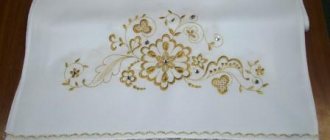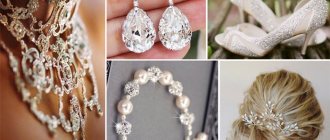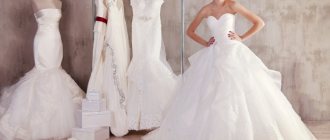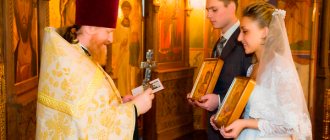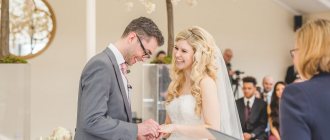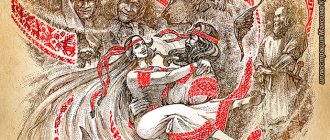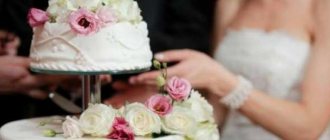Repair and decoration
04/09/2018 Anastasia Prozheva
The cross stitch pattern for a towel may vary in complexity. Rushniks are part of history. They were embroidered back in the days of our ancestors as a wedding amulet. Used for various celebrations, christenings, and to decorate the hut. And what patterns on embroidery! They are a real work of art. Of course, at first glance, embroidery seems complex, intricate, and it becomes difficult to believe that such beauty can be created with your own hands. And there is a desire to buy a towel in the store. However, it is quite possible to embroider it yourself.
Embroidered towels photo
A towel is a canvas (linen, hemp) that is decorated with embroidery.
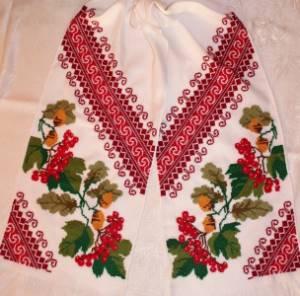
The towel was embroidered with a specific ornament, which served as a talisman and protection. Each element of the drawing has its own symbolism and carries a certain semantic meaning.
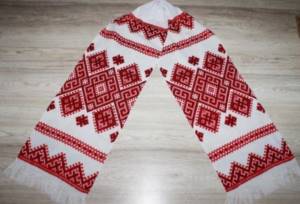
It has long been believed that an embroidered towel has its own power, can help in various situations and protect. Therefore, earlier embroidered products were not intended for beauty, they performed their specific function.
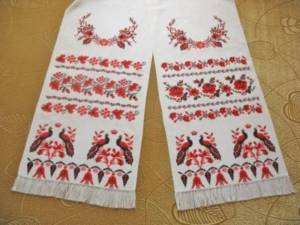
Crocheting patterns for towels
Crochet lace for a towel is used as a border. The pattern is usually knitted separately and then sewn to the finished embroidered towel. Crochet patterns can be found in specialized magazines or on the Internet.
How to knit a pattern for a towel, watch the video.
Using a towel for weddings is an old tradition that dates back to ancient times. In the future, the towel is kept by the husband and wife throughout their life together. It cannot be re-gifted or used in everyday life.
Embroidery pattern for a wedding towel
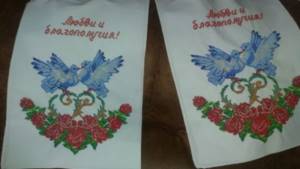
The variety of towels during a wedding event indicates the great ethnic role of the towel at every stage: from matchmaking to wedding. In the old days, it was believed that the bride had to embroider towels and outfits with her own hands. Once upon a time, the number of towels used at a wedding ceremony reached 40 pieces.
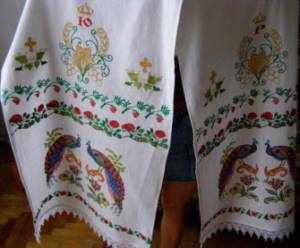
Today the number of towels has been reduced to 5-6:
- wedding - spreads under the feet of the newlyweds in church, registry office,
- allied towel - their hands are tied,
- “godniks” - two towels are used for icons,
- towel for the Gospel,
- a hospitable towel - a loaf is placed on it.
One of the main ones is the towel, which the newlyweds stand on during the wedding ceremony and painting. According to beliefs, it was believed that it should be long, because its length is a symbol of life together. The towel must be white; this color speaks of sincerity, honesty, and trust. Previously, they even embroidered such a towel with white threads so that life together would be bright.
The drawing should be beautiful, rich, then the couple’s life will be rich and bright. Opinions differ on the issue of the pattern of the towel, which is laid under the feet. Modern copies often contain wedding symbols - wishes, doves, rings. In the old days, it was believed that it was not worth using such symbols, because young people, when they stood on the towel, could trample on the good moments in their lives. Therefore, most often such towels had neutral motifs: floral, geometric patterns.
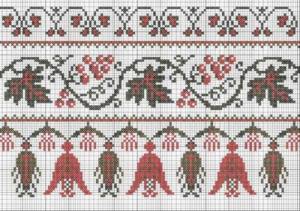
Meaning, symbolism, origin
The cult of bread and the special attachment of people to grain has created a wedding tradition that involves a loaf of bread. Therefore, this element has long been used at weddings. The loaf symbolizes wealth and fertility. The loaf should be round. In this case, the young family receives a blessing for a life of abundance.
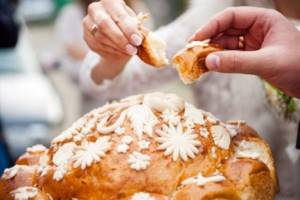
The newlyweds were greeted with a loaf of bread after the wedding (the bread was eaten from the middle, this is symbolic, because it resembles the origin of life). After the couple had tasted the bread, the loaf was offered to relatives and guests, who could also try it. Anyone could taste the loaf and give something in return (make a present for the young people).
All guests receive their own piece of loaf, which they can share with their family at home. Everyone who tries a loaf gets good luck (especially in new business, road or travel). Loaf decorations are distributed among unmarried girls, thereby wishing them happiness in their personal lives and a speedy wedding.
How to make a wedding towel for a loaf - the diagram below shows:
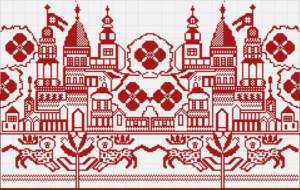
Embroidery pattern for Easter towel
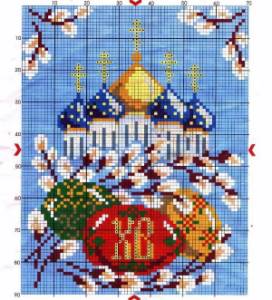
An Easter towel is a towel, the design on which is supposed to tell about a joyful event - the resurrection of Jesus. It is believed that the main colors for such a towel are black and red, and can be complemented with other shades. The drawing should not be very large. It was once believed that the middle (center) of the Easter towel should be left empty, since this is the place for God.
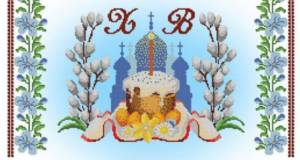
Krashanki (a symbol of life, rebirth) are considered obligatory elements of the design of Easter towels. Easter cakes (a symbol of fertility) are also often depicted. On modern products you can find other motifs that came from other faiths.
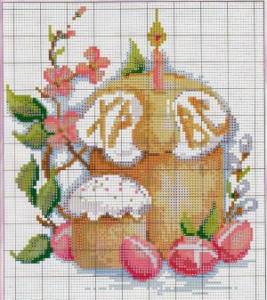
There are no restrictions on the size of the Easter towel, but the canvas must be solid, so it is not advisable to decorate it with hemstitching; you can decorate it with fringe and tassels.
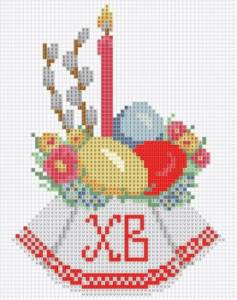
The embroidered pattern on the towel should be neat on both sides. It is believed that the front side is intended for man, and the back side is for God. It is embroidered with a cross, but there can be two versions of the cross: Russian or Bulgarian (more complex).
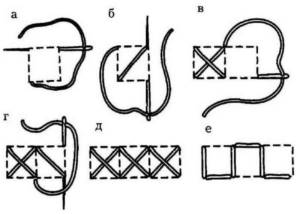
Roots of tradition
It was believed that if, during the engagement, the future husband and wife were tied with a towel, this would become the key to a strong, unbreakable union.
Previously, it was impossible to buy an embroidered towel, since it was believed that it was the bride’s responsibility to embroider and decorate it. Thus, the groom and his family had to see what she was like in housekeeping and skill.
In addition, the towel played an important role as a family “symbol”, a sign of the family. When a young wife came to her husband’s house, she had to change this “symbol” and hang her own hand-embroidered and decorated canvases in the house.
How many towels do you need: then and now
There should have been several towels. Many wedding ceremonies were accompanied by this beautiful detail:
If they ate together with bread and salt, then they would not be able to break their words. This tradition is still revered by newlyweds and represents one of the most important wedding rituals. Both the bride and groom bite off or break off a piece of the loaf. It is believed that the one who gets the larger piece will become the master in the new family.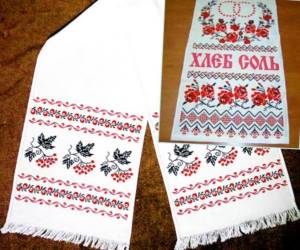
The towel for the loaf was used to serve warm bread to the matchmakers.- The towel for the icon was needed so that parents could bless their children with the icon. They carefully and neatly framed it with a towel.
- A towel for the newlyweds to stand on after the wedding. This is a symbol
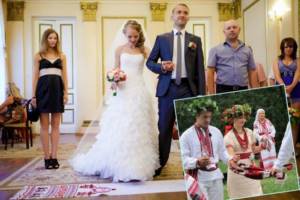
brought peace and tranquility to the family. If this is forgotten or overlooked, and the young people have to stand on the ground, then there will be quarrels and swearing in their family. It was necessary to stand on the towel at the same time in order to attract harmony and mutual understanding into the family. Now this tradition, albeit slightly modified, still exists. The bride and groom stand on it during the wedding or wedding. - A towel used to bind newlyweds. Symbolizes the strength of the marriage and the consolidation of the marriage ceremony.
How many of them will be needed at a modern wedding depends on what ancient traditions the newlyweds want to recreate. In addition, there are those who buy a towel for each invitee as an original and beautiful gift.
Where to find a towel
Buying a towel for a wedding is not difficult . There are many places where beautiful and high-quality towels are sold.
But according to tradition, you need to embroider it yourself. It is also good when the mother of the bride gives her daughter a towel of her own embroidery, because it can bring peace and love to a young family.
Making it yourself is not at all difficult. Even for those who have never held products intended for sewing and knitting before.
Embroidery of towels for a wedding
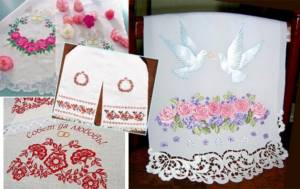
You need to buy fabric about 3 m long and 50 cm wide. Basically, a wedding towel is cross-stitched. This is the most common technique for these products. This process is labor-intensive, so it is not recommended to embroider them all. The most important thing is to make the main one yourself and buy the rest.
It’s better not to start work on the eve of the wedding, but to set aside at least 2 weeks for it. It is believed that you should sit down to embroidery only in a good mood, otherwise you can bring negativity on your family.
There are many cross stitch patterns, so you can choose the one that suits you best. Each color, pattern and line has its own meaning, so it's best to become familiar with the symbolism in advance to select the characteristics that you want your family to have.
You get very beautiful models if you embroider with beads.
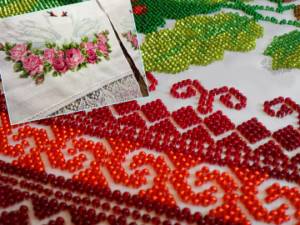
Symbols of patterns and designs:
- Oak – strength and durability;
- Poppy – feminine sophistication, large families;
- Rose – beauty, softness of heart;
- Dove – loyalty to family and spouse, love.
- Viburnum - family well-being, health;
- You can embroider some words under the pictures.
Satin stitch embroidery towels patterns
Satin stitch embroidery provides more opportunities for creative freedom. In fact, you can embroider any design; you just need to transfer it to the embroidery fabric. For satin stitch embroidery you need several basic tools and materials:
- needle (must have a sharp end),
- frame (hoop),
- threads (matched to a specific fabric),
- fabric (smooth or counted).
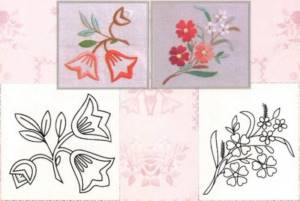
There are several directions for satin stitch embroidery:
- Russian satin stitch - stitches are laid either horizontally or vertically, a gap of approximately two threads is left between the stitches, and on the way back these gaps are filled,
- artistic embroidery - several different colors are used here to make a smooth transition from one tone to another, embroidery technology - bias stitch without flooring,
- satin stitch - laying thin threads that begin in the middle of the next stitch, close to each other, without gaps.
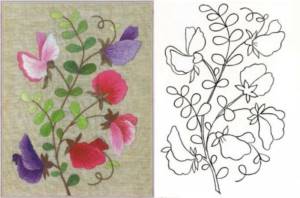
The main technique for embroidery is the oblique stitch. This technique is characterized by the fact that the stitches are laid close to the second element in shape. In this case, the pattern is obtained from the front and back sides. And in order not to forget in which direction and at what angle to place the stitches, you can simply draw guide lines on the fabric.
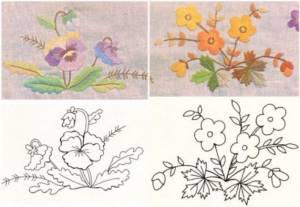
Another secret: to get convex, voluminous parts, two layers of stitches are used: the first layer may not be too dense, the next layer is placed on top of this ball, where the stitches are already tightly laid.
Details: cross stitch pattern for a towel (photo examples)
The best posts
- Rock garden in the garden: DIY Alpine slide (30 photos)
- [Plants in the house] What indoor flowers are in fashion now?
- What can be made from an old washing machine?
- Short sleeve pullover
- Decrease loops by crochet in a circle in an openwork pattern with video
- Decorating a small bedroom with an area of 6 sq. m (+50 photos)
- Which door to choose for the hall: options in the photo
- Frost-resistant plants for the balcony
Article on the topic: Organization of drainage of air conditioner condensate into the sewer system
Bead embroidery pattern for towels
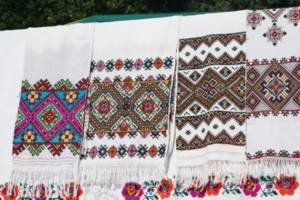
Towels, which are embroidered with beads, are often used as amulet signs. The bead embroidery technique is close in its implementation to the half-cross technique. When embroidering with beads, the peculiarity is that in each stitch a bead is strung on the front side. And on the wrong side you get vertical stitches.
When embroidering with beads, you must remember that in each row the direction of the beads being sewn changes: odd rows start from the left, moving to the right, even rows - from the right to the left.
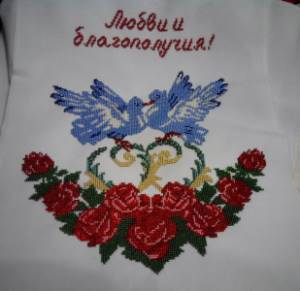
Ukrainian embroidery towels patterns
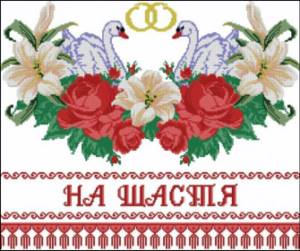
The Ukrainian towel is a symbol that reflects the history of an entire people.
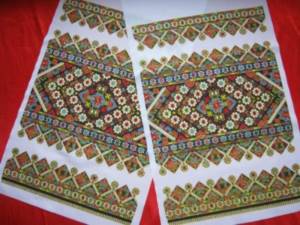
The key pattern on the Ukrainian wedding towel is the tree of the genus, which grows from a flowerpot or pot. The bottom flowers are a reminder of those family members who have passed away, the middle row of flowers are the families of parents and grandparents. At the top they embroidered buds, flowers that had not yet bloomed - these are future children.
Above the flowerpot and below the flowerpot, no patterns were embroidered. It was believed that the pattern, which is present above the flowerpot, blocks the connection with God. The lower part, which went under the vase, is a symbol of the world of the dead, into which it is better not to meddle.
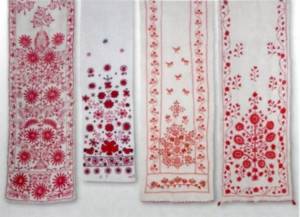
Another element that is often present on Ukrainian embroidery is the symbol of the Mother. This is an eight-pointed pattern in the form of a star, a flower, a line and a garland of flowers are embroidered around it. Such an embroidered garland signifies recognition of the Mother’s great participation in the life of the clan, her glorification.
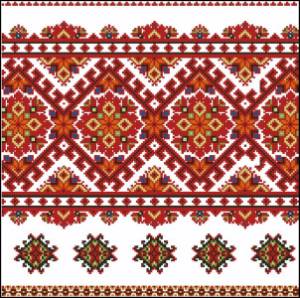
How many towels do you need for a wedding?
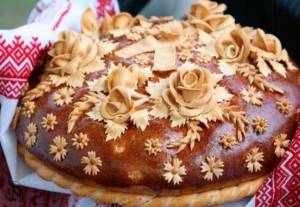
Traditionally, a wedding towel is considered to be the one used in the registry office. Previously, this particular towel was also hung behind the newlyweds during the festive feast. Or a separate towel was embroidered for this purpose. Wedding traditions also require a towel for the icon, with which the parents bless the newlyweds, and a towel for the loaf. In the past, it was also customary to embroider towels for friends and matchmakers. However, today this tradition is generally not observed.
You can embroider all the towels yourself, or you can embroider only one of them.
Towel for icon embroidery pattern
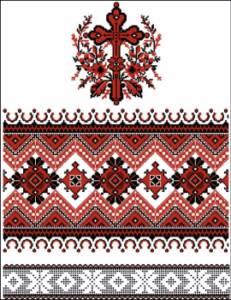
Bozhniks (towels for icons) have always occupied a special place among other products. Once upon a time, such towels reached a length of about three meters. The icons were framed with embroidered long beautiful towels on major holidays. There were also regular towels, which were used to decorate icons on weekdays.
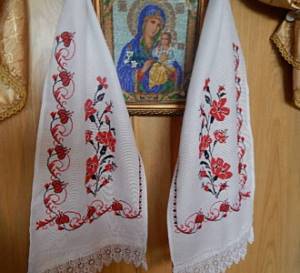
In the wedding ritual, the presence of two embroidered towels under the icons is necessary - separately for the groom, separately for the bride. It was believed that towels should be different, but they could be united by a pattern that symbolically denoted well-being (grapevine). Each element of the pattern carried its own meaning:
- dove, dove - a symbol of family, peace,
- rooster is a sign of wealth, happiness, strength,
- peacock - family happiness.
Such towels always contained elements that reflected the feminine (viburnum, lily) and masculine (oak leaves, acorns) principles.
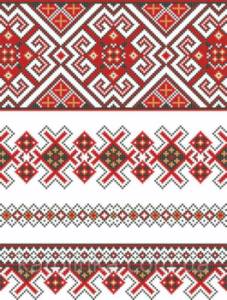
The most popular, classic option was cross stitching. Today, such towels can also be embroidered using beads.
Download diagrams
Below you can download patterns for embroidering a towel for a wedding. The images are presented in good resolution and can be printed on A4 sheets for convenience:
Additionally : What do the symbols on towels mean? Detailed article at the link .
Embroidery patterns for towels under feet
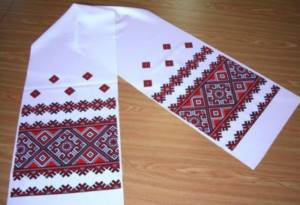
It is believed that the towel, which is laid under the feet of the bride and groom, is the main one, because it is on it that the couple’s journey is captured. Initially, people did not stand on such a towel, but young people knelt down. Initially, such products depicted a vine, grapes that were supposed to bring prosperity and prosperity to the new family. On one end of the towel—the male side—oak leaves and acorns were embroidered, which symbolically reflect male strength.
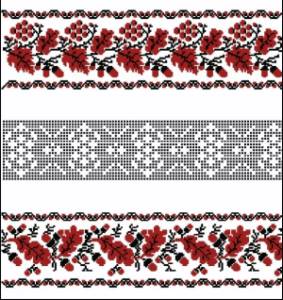
On the female side, viburnum was often present - a sign of female beauty, procreation.
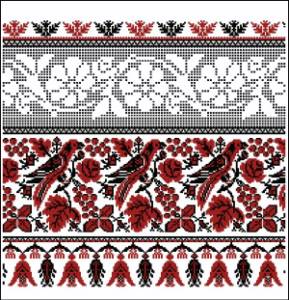
The wedding towel was embroidered with one needle, it was not changed. And if the needle becomes dull or lost, then it is better to put such a towel aside.
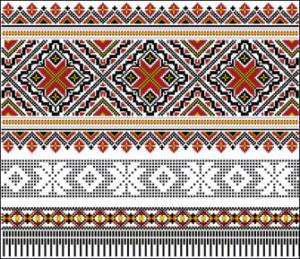
It is advisable to create a pattern for a wedding towel yourself. You should not completely repeat someone else’s drawing, because in the old days it was believed that in this way a person borrows someone else’s destiny. That is why it is better to complement any pattern with your own touches. An exception may be the pattern of the parent's towel; it can be repeated if the parents had a happy fate.
DIY wedding towel
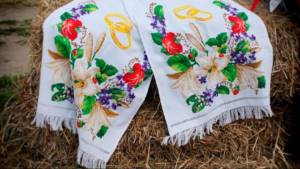
A towel is a traditional element of a wedding. Our ancestors passed on the secrets of its creation from generation to generation. Previously, every girl sewed a towel for a wedding with her own hands, putting all her feelings and skill into the work. Today this activity is less popular, but sewing a towel with your own hands is not as difficult as it seems, provided that you have enough patience and time. Which technique is easier to sew a wedding towel with your own hands? The cross stitch pattern is the simplest and is suitable even for beginner needlewomen.
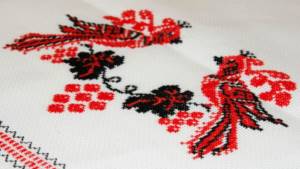
DIY wedding towel
Before you sit down to embroider a wedding towel, answer yourself the following questions: for what purpose is it needed, what design or ornament will decorate it, what color is best to make the product?
During the sacrament of the Wedding, a towel is laid under the feet of the bride and groom, and then the hands of the newlyweds are tied with it. The wedding towel is used when offering a loaf of bread or blessing the newlyweds with icons.
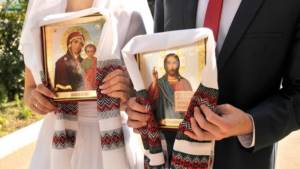
Each of the traditional symbols depicted on towels has its own meaning:
— the cross reflects God’s grace and blesses the newlyweds for marriage;
— paired birds (pigeons, swans) symbolize friendship and love;
— viburnum, oak and grapes are considered the personification of prosperity and family well-being;
— a tree is a symbol of family and a strong connection with the clan.
The phrases “Advice and love”, “For good luck”, “Save and preserve” are often embroidered under or above the main design.
Since you make the wedding towel yourself, the embroidery on it can be very diverse. It is important that the chosen symbols resonate in the soul.
Traditionally, patterns on towels are made in black-red or blue-red colors. However, monochrome ornaments and full-color floral arrangements can look no less interesting.
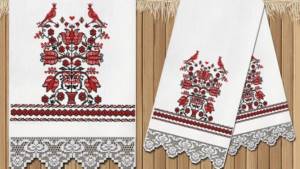
Do-it-yourself towel for a loaf of bread for a wedding
To embroider a towel for a loaf or icon, as well as a towel for a wedding with your own hands, remember the basic rules:
- The towel must be carefully embroidered not only on the front side, but also on the back side: let family life be clean inside and out. Try to create the same pattern on the back and front sides. Avoid knots and long thread transfers. But there is no need to remove minor errors: without them, life is impossible.
- The wedding towel is embroidered symmetrically, but the middle remains white and is not sewn up. It symbolizes the connection with God and is called “God’s place.”
- The groom's side is embroidered first, then the bride's side.
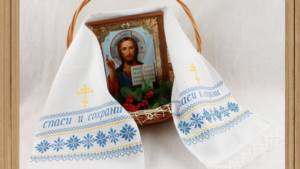
We will need:
- floss threads in the desired colors
- cross stitch fabric (canvas), linen or cotton, about 3 m long and 50 cm wide (depending on the chosen pattern and pattern)
- needle
- scissors
- pencil
- hoop (when working with soft fabrics)
Step-by-step instruction:
- If you use a special impregnated canvas for the towel, you can immediately start embroidering. We pre-wash and steam any other fabric to ensure uniform shrinkage of the textile before starting work.
- For a symmetrical arrangement of drawings and patterns, we mark the middle of the future towel with a simple pencil, folding the prepared piece of fabric in half lengthwise and smoothing the fold.
- We choose a pattern and remember that only the edges and part of the fabric above are embroidered on towels. More scheme options can be seen below.
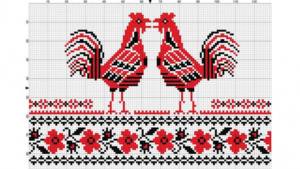
- We calculate the number of repeating sections (rapports) according to the selected scheme. We outline the fragments on our canvas, counting the required number of cells. For convenience, you can draw the outline into squares of 10 cells each.
- Install the hoop.
- We fasten the first thread.
- We consistently create the selected pattern. On a long row, we sew stitches first in one direction, then in the other direction in reverse. We embroider single crosses right away.
An important point: so that the embroidered towel does not have knots, at the beginning and at the end we secure the thread by pulling and entwining other threads of our embroidery.
- After completing the main pattern, we process the edge. To do this, fold the fabric in half and hem it with hidden stitches.
You can combine this process with additional decoration of the towel - hemstitching. In addition, the hemstitch pattern is used to decorate the cross-stitched pattern on top or to separate the stripes of the ornament. Often, instead of decorative hemming, lace is used on the edges of the towel.
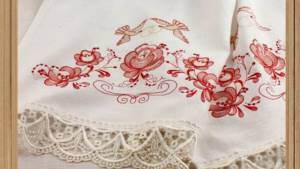
Previous Next
- We wash the finished work in water acidified with vinegar. This will make the thread color more stable.
- Steam the product.
Your unique towel is ready!
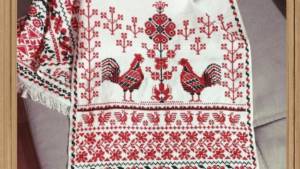
As you can see, the most necessary thing to embroider a towel for a wedding with your own hands is patterns of ornaments and designs. Below you can view and download several interesting embroidery patterns for wedding towels.
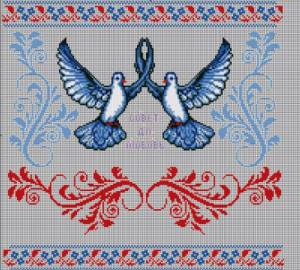
Link to the schematic archive
When embroidering a towel for yourself or your loved ones, it is important to remember the feelings that you put into your product. Pure thoughts and good wishes will turn a wedding towel into a priceless gift that will decorate the important moments of creating a future family.
Prepared by Anastasia Parkhomchik
15.09.2020
Embroidery of Slavic towels patterns
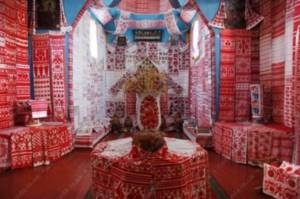
The process of creating towels is creativity, magic. When creating embroidered work, craftswomen not only put into it skill, energy, charge, but also their soul and love. Therefore, an embroidered towel is not just a beautiful thing that pleases the eye, but also an object that can become a talisman for a person, helping him to recharge himself with positive strength.
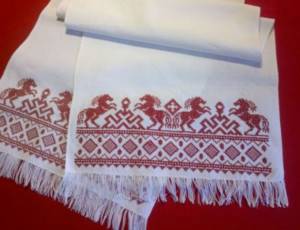
Since ancient times, Slavic culture has distinguished several types of towels, each of which performed its own function:
- Handbrake - it was used to wipe the face and hands. These products were embroidered in a special way, the main patterns were swastikas, and later rhombuses. At the same time, when the lower edge was embroidered, wide stripes were embroidered first, then narrow ones, and the upper edge, on the contrary, was embroidered from narrow to wide stripes. This pattern meant the rising and setting of the sun, which is why they wiped themselves with such a towel according to a special ritual: in the morning they wiped their face with the lower end, and in the evenings with the upper end. They believed that in the morning a person received strength, and in the evening he relieved fatigue with a towel.
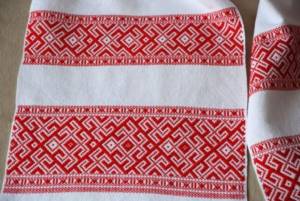
- A fly is a small towel-shawl. Often embroidered with white thread. This type of towel was used by the bride to wipe away her tears; it was tied on the bride’s hand when she was taken away from her parents’ house.
- Bozhniks are towels that were used to decorate icons.
- Maternity - a towel in which a child was received at birth.
- Podorozhny is a towel that was given to people leaving their home. A simple but thoughtful pattern was embroidered on them, the symbolic meaning of which was the wish for an easy journey, a successful return home.
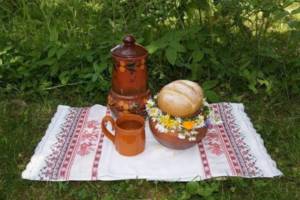
- An ordinary one - a towel, which was embroidered over the course of one day. It was believed that such products had protective functions, because they were made during the day, when bad forces had no power. Such towels were created only when necessary; they were not embroidered in advance, so they were used only for a specific purpose (cattle were driven through such a towel to avoid diseases, a road was laid out for rain during drought).
- Wedding - there were several types of such towels, each of them performed its own task.
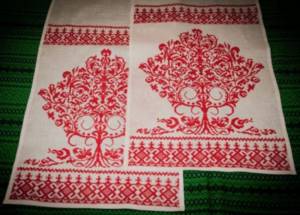
- Funeral - they accompanied a person on his last journey, they were hanged on graves. They embroidered modestly, just a narrow strip along the edge, often with white thread.
How to embroider a towel correctly
I was inspired to embroider a towel and came across a bunch of information, I think it might be useful to you, dear needlewomen! Taken from here
I want to tell you how towels are embroidered in the south-eastern and central regions of Ukraine.
In general, several towels were embroidered for the wedding; I can only say approximately how many. Two were embroidered for the matchmakers (bandaged), one for the icon with which the newlyweds were blessed, one for the bread, and two more for the boyfriend and boyfriend. The main towel was embroidered for the newlyweds, it was laid under the feet when they got married in church, and it was hung over the newlyweds at the table (sometimes a towel was embroidered separately for the table).
Now, most often, the bride embroiders one wedding towel with her own hands, for painting and wedding, and under no circumstances leaves it in the church. Ideally, the bride should be preparing for the wedding, so she should embroider her trousseau in advance, including a towel on one edge, and immediately before the wedding, the other edge, the groom’s, is sewn on (see picture).
Now a little about the material:
Now it is convenient to use fabric for embroidery with small cross stitches (such as AIDA 14). The length of the fabric is 2.5-3 meters, the width is at least 45-50 cm. The width is determined by the repetition of the pattern, the length - by the amount of embroidery (the middle should be enough to accommodate the bride and groom).
If a fabric without an edge is used for a towel, then the towel is hemmed by hand, the hem depends on the fabric - linen or calico is folded 2 times by 0.5 cm. Hemming is done, grasping the base thread through a cross, so that a dotted line is formed on the face. There should be no white border on the sides of the embroidery; the design should be symmetrical.
For me this is the most tedious part of the job! I hem both short sides and one long side, leaving the other for the hem, depending on the pattern. Usually it is embroidered with crosses using two threads.
About the towel embroidery itself:
The towel is embroidered differently on both sides, for the groom and for the bride (as described above). The only thing that is common is the design and size of the embroidered part.
A towel is embroidered in three layers:
- the first is a tree of the genus, and usually trees with a pair of birds accompany it
- the second is a wish for the bride and groom
- the third is bereginii, and finally a wedding wreath is embroidered with the initials of the bride and groom.
The border is embroidered first. It can be different - embroidered imitating tassels, or lace. You can sew lace (preferably knitted by hand), or you can pull out the fabric and make tassels. I prefer to embroider (see picture).
Then they embroider the family tree and alternate it with trees where birds sit in pairs (a symbol of a couple), the trees are very different, with swallows, with depths, the oldest with animals unknown to science, similar to deer, but certainly under the tree, the most common now with peacocks .
For example:
Between them, the most interesting and the most inconspicuous on the whole towel is the tree of the genus .
It grows from a pot, the modifications are different, it has two nodes, the first is parent, the second is child.
The first branches (under the central parent node) are the grandparents, the bride or groom (depending on the side of the towel), the branches down are dead, the branches up are alive. On the right are the mother's parents, on the left are the father's parents. The upper branches are grandmothers, the lower ones are grandfathers. On the central node, with dots, are the aunts and uncles of the bride (in accordance with the side of the parent), and if on the lower side they are older than the father (mother), on the upper side they are younger. For women, a triangle is embroidered, for men, a square (4 crosses).
The second level (above the central node) is parents. Similarly, on the right is the mother, on the left is the father. Branches up are alive, branches down are dead. In general, logically there should be one branch, but for some reason they embroider two (probably for symmetry).
The top (child node) - the brothers and sisters of the bride (groom) are dotted on it. Above are the older ones, below are the younger ones. On the right are the sisters (maternal side), on the left are the brothers (paternal side).
Now, based on the above - in the picture: the tree of the bride’s family (loop), her mother is an orphan (her grandparents died - branches are from right to bottom), her father’s parents are alive, her parents have no brothers and sisters (that is, the bride has no aunt and uncles), her father and mother are living, and she has an older brother.
The bride has a loop embroidered on the top knot, and the groom has two extra squares.
But in this picture: the tree of the groom’s family , all the grandmothers (upper branches) are alive, the grandfather on the mother’s side is dead. The groom has one aunt on his mother’s side and one uncle on his father’s side, his mother died, he is the youngest in the family, after his brother and sister.
Next they place a stitch with wishes to the bride and groom. They embroider roses for the bride - a symbol of beauty, lilies - a symbol of purity, carnations - a symbol of fidelity, poppies - a symbol of procreation. For the groom, grapes are embroidered - as a symbol of wealth, oak - as a symbol of strength, perseverance, strength, they combine it with viburnum - a symbol of the continuity of family life. The main motif is surrounded by small stitches of modest patterns of a suitable theme. Lilies are necessarily accompanied by a pattern containing a cross.
For example:
There can be many options, it depends on the imagination and desire of the embroiderer. Embroidery samples can be found anywhere, in books, on the Internet. Next, bereginii are embroidered, these are small stylized trees in pots, although there are options without them. They are found instead of a tree, like a later version - a cross. They embroider on both sides of the towel, leaving the middle for the wedding ring. The wedding ring is embroidered in the middle, it is usually crowned with a crown, a symbol of a wedding in a church; in fact, it is a wreath.
The initials (the first letter of the name) of the bride and groom, respectively, are embroidered inside the ring. Here are examples of the bereginya and the cross:
And this is what the rings look like:
The initials are embroidered in any font you like. The result should look something like this:
I wish you success in your work, I recommend using the Paint program to create your project, it’s very convenient to type crosses in the grid!
HOW TO EMBROIDERY A FAMILY TREE:
It grows from a pot, the modifications are different, it has two nodes, the first is parent, the second is child. The first branches are under the central (parental) node - grandparents, bride or groom (depending on the side of the towel), branches down - dead, up - alive, on the right - the mother's parents, on the left - the father's parents. The upper branches are grandmothers, the lower ones are grandfathers. On the central node - with dots - the groom's aunts and uncles (in accordance with the side of the parent), and if on the lower side they are older than the father (mother), on the upper side they are younger. For women, a triangle is embroidered, for men, a square (4 crosses). The second level is parents. Similarly, on the right is the mother, on the left is the father. Branches up are alive, branches down are dead. In general, logically there should be one branch, but for some reason they embroider two (probably for symmetry). The top (child node) - the brothers and sisters of the bride (groom) are dotted on it. Above is older, below is younger. On the right are the sisters (maternal side), on the left are the brothers (paternal side). The bride has a loop embroidered on the top knot, and the groom has two extra squares. Now, based on the above - in the picture: the tree of the bride’s family (loop), her mother is an orphan (grandmother and grandfather died - the branches are from the right to the bottom), the father’s parents are alive, the parents have no brothers and sisters (that is, the bride has no aunt and uncles), her father and mother are alive, and she has an older brother. Tree of the groom's family, all grandmothers (upper branches) are alive, maternal grandfather is dead. The groom has one aunt on his mother’s side and one uncle on his father’s side, his mother died, he is the youngest in the family, after his brother and sister.
The towel must be white, as a symbol of purity and fidelity, and long - from 2 to 4 meters, and the longer the “wedding” towel, the longer the road of life will be. It is this that is kept throughout life and wrapped around the newborn child for the purpose of spiritual protection.
ADDITIONAL INFORMATION, LINKS TO ARTICLES AND DIAGRAMS:
https://www.handbookbride.ru/main/trouble/245-svadebnyj-rushnik.html
https://vk.com/topic-29872577_26824641
https://club.osinka.ru/topic-8547
https://www.igolki.org.ua/index/rushniki/0-9
https://vk.com/album-29872577_141717795
https://crestik.ucoz.ru/forum/32-21-1
https://crestik.ucoz.ru/load/vyshivka_ikon_rushnikov_pokrovcov_sekrety_cerkovnykh_masterov/37-1-0-698 -BOOK
https://uzoranet.livejournal.com/21039.html
https://rukodelnitsa.info/vishivka-krestom/rushniki/cxemy-rushnikov-podborka-3.html
I read an interesting article about towels in the magazine “Workshop at Home”
, author of the article: Natalya Svezhinets, Krivoy Rog
The needle itself is a wonderful amulet, an energy conductor that sews all thoughts and dreams into the fabric. And the canvas is nothing more than a sacred bundle that carries a huge flow of positive energy.
Combine these two most powerful energy conductors together, what happens? And if you put a little effort, skill, and good positive thoughts into it, the result will not take long to arrive.
Usually 3-5 towels are enough: under bread and salt, under the feet of the newlyweds, to tie the hands of the bride and groom so that they always walk hand in hand. And then - at the discretion of the parents: matchmakers, under an icon, under a loaf.
Towel under your feet
- the most important person at the wedding, he is the one who decides how the future life of the bride and groom will turn out. On this towel you cannot embroider a pair of birds, which symbolize the newlyweds, the wish “For good luck!”, flowers, rings - when the newlyweds stand on such a towel, they will trample on everything that could be good in their life. The best option for embroidery is a geometric pattern or bunches of grapes - these are symbols of family, wealth, and well-being.
It is advisable that the bride herself embroiders this towel and at the same time makes 10 differences at the ends of the towel (on the male and female sides). The side that is embroidered first should be considered masculine; it is embroidered with great desire, therefore its charge will be positive (everything comes from the basics of life - this is the age-old wisdom).
If a girl begins to embroider a towel herself, it is impossible for her mother or sister to help her - they will send her son-in-law away or discourage her).
Towel under a loaf, bread and salt
- the most unlimited choice of patterns. It is on this towel that a couple of birds kissing with their beaks, wishes, family trees and a sea of flowers are embroidered so that the life of the newlyweds is strewn with happiness, joy and flowers.
Towel to tie hands.
Previously, they used pure white (can be embroidered with white) to make life cloudless, or embroidered only with red threads - for joy.
Towel under the icon.
Usually it was decorated with embroidery with weaves of viburnum and oak.
A FEW GOLDEN RULES
* You can’t decorate towels with hems - life will be full of holes.
* You cannot embroider wedding towels at night - only magical things are embroidered at this time of day.
* Embroidery should be clean and neat on both sides - the front side for people, the back side for God.
* A towel is the road of life, therefore its panel must be whole and continuous, like life (do not insert any lace or ribbons into the middle of the towel - this will only cause harm; you will not be able to sew a cut life back together, no matter how hard you try).
* Pairs of birds such as falcon, turkey, peacock, and rooster are embroidered on wedding towels (but not in a fighting stance). Do not embroider cuckoos - a widow's symbol, nightingales - a symbol of unmarried guys (so that the husband does not cheat).
* All dimensions of the towel (width, length) must be divided by 7. 1/4 of each half of the towel should be filled with embroidery.
* The center of the towel must remain empty, without embroidery - God’s place. By standing on the towel, young people receive a blessing from above.
* After the wedding, towels are kept in the newlyweds’ family as a symbol of a happy family life, rolled into a tube, so that all evil spirits will walk around in circles and understand that they have nothing to do here.
* Towels, especially under the feet, are used once! In the case of a very happy family life, only the pattern is inherited, and a new towel is embroidered.
* Towels are not rented - after all, fate does not rent.
Here's a little more about the symbolism of the patterns.
Rushnik
- the product is deeply symbolic and multi-valued. Created according to the laws of art, it not only decorates everyday life, but is also a symbolic reminder of the invisible connections that connect each person with his family and ancestors. We can safely say that the patterns of embroidered towels are an encrypted story about the life of the people, nature, people.
The importance of the towel in wedding rituals is evidenced by individual names. For example, matchmaking in some regions of Ukraine was called taking towels or giving towels (Kirovograd region), towels (Kharkiv region), giving towels (Kiev region). The attributes of matchmaking and a sign of the girl’s consent to marriage were towels tied to the matchmakers or bread presented to the matchmakers on the towels. Accepting the gift, they said: “Thank you to the father and mother for waking up their child early and teaching them good deeds. Thanks also to the girl who got up early, spun finely and embroidered good towels.” In some regions of Ukraine towels were not called matchmaking, but betrothal - the first wedding ceremony that had legal force at the wedding. The ritual binding of the hands of the bride and groom was carried out by the senior elder. He covered the bread with a towel, placed the hands of the bride and groom and all present relatives on it, tied it with a towel, saying: “It is not the knot that is tied, but the word.” After this, the headman untied the symbolic knot, and the bride tied the matchmakers with towels and presented everyone present with shirts, linen or scarves.
Water and Sun
All Ukrainian embroidery is marked with the signs of Water and Sun. The Sun is often depicted as an octagonal rosette or flower, and the Water sign resembles a coiled snake. Two elements that created earthly life, and therefore they must be understood as moist maternal and solar paternal energies.
Mother symbol
The main symbol on the towel is the symbol of the Mother, which is based on an 8-pointed star, as mentioned earlier.
This symbol is framed by a stylized garland of flowers, which symbolizes the greatness of the mother, her special role in the continuation of life. The presence of yellow and blue threads in the design indicates the Ukrainian roots of this embroidery. Diamonds
The most common ornament in Ukrainian embroidery (although in fact it was common to all East Slavic peoples; Russian embroidery also has many similar patterns) was a geometric ornament, the main elements of which were “diamonds with squiggles.”
According to ancient Slavic beliefs, they embodied the goddess of the earth and served as a good protective symbol that brings happiness and protects fertility. It is the presence of the latter meaning that explains the wide distribution of this amulet ornament in ritual clothing, especially women's. Embroidery with such signs in women's clothing was located on the headdress, chest and shoulder pad, in men's clothing - on the shoulder pad, as well as on the sleeves and hem of the embroidered shirt. Flowerpot and Bereginya
Embroidery, the ornament of which consisted of a flowerpot (large branches with flowers and birds) and Bereginya (a stylized female figure or a mysterious powerful flower), also served as an ethnic talisman sign of the Ukrainians. They were usually embroidered with red threads, which symbolized purifying fire and the sun and was associated with protective magic, amulet, purification and healing.
Grape
The symbolism of grapes reveals the joy and beauty of creating a family.
A vineyard garden is a field of life in which the husband is the sower, and the wife is obliged to grow and care for the family tree. The grape motif is visible on women's and men's shirts in the Kiev region and Poltava. In Chernigov, grapes climb on family towels. Stars Stars
, scattered on the sleeves and collected in a geometric pattern, are an idea of the structure of the Universe, which is no longer chaotic, but ordered and filled with harmony..
Oak
Oak is a sacred tree that embodied Perun, the god of solar male energy, development, life.
Consequently, young women and young men always had with them a magical amulet of the life-giving power of their family. Viburnum
Viburnum is a tree of Ukrainian origin.
Once upon a time in ancient times, it was associated with the birth of the Universe, the fiery trinity: the Sun, the Moon and the Star. That is why viburnum received its name from the Old Slavic name for the Sun - Kolo. And since viburnum berries are red, they became a symbol of blood and immortality. That is why all wedding towels, girls’ and even men’s shirts are heavy with mighty bunches of viburnum. Lilies
In legends, the lily flower is a symbol of girlish charm, purity and innocence.
If you look closely at the outline of the geometric pattern, you will see the silhouette of a pair of birds - a sign of love. In addition to the flower, an integral part of the ornament was a leaf and a bud, which form an inextricable composition of triplicity. The lily contains the birth, development and infinity of life. Sometimes dew drops are embroidered above the flower to signify fertilization. Lily is a female symbol, the very essence of moisture energy. This is confirmed by the ancient name of the flower - krin. Let's compare this name with the Ukrainian word “krinitsa” - well. Poppy
Since ancient times, poppy was sacred in Ukraine and people and livestock were sprinkled with it, because they believed that poppy had magical powers that could protect against any evil.
They also believed that in the spring the field after the battle was covered with poppies. A gentle and quivering flower carries the unforgettable memory of the family. Girls whose family had a deceased person embroidered poppy patterns on their shirts with love and longing, and put wreaths of seven poppies on their heads, promising through this ritual to preserve and continue their family line. Rose
The old name of the rose, rouge, is consonant with the ancient name of the Sun - Ra.
In addition, there is an old Ukrainian name for blood - ore. Patterns with roses were formed according to the laws of floral patterns, which meant endless solar movement with eternal rebirth. Where roses are arranged in a system of geometric patterns, these plants are not just flowers - they are star flowers that embodied the people's idea of the Universe as a system. Hops
Hop leaves can be considered youth symbols. In addition to central Ukraine, the pattern is widespread in Podolia. Hops are close to the symbolism of water and grapes, because they carry a sign of development, youthful exuberance and love. We can say that the hop pattern is a wedding symbol. A folk song suggests that “curling” for a boy means being ready for marriage, since for a girl getting married means “knitting buns.”
Belarusian towel schemes
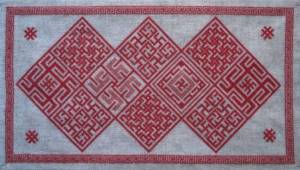
One of the distinctive features of Belarusian ornaments is the use of geometric shapes: squares, stars, circles, quadrangles, rhombuses, stripes. Sometimes such patterns smoothly transform into plant motifs. Floral ornaments were mainly depicted: flowers (most often acacia, lotus), leaves, fruits (grapes)
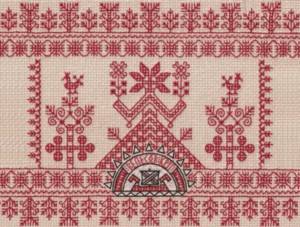
Another distinctive feature of Belarusian towels is the absence of symbols of death. For Belarusians, the pattern on embroidered items acts as a talisman; it must carry a positive charge. Initially, the ornament was embroidered on a white background using red threads. It is believed that only this nationality managed to preserve the type of patterns that existed among the ancient Slavs. White color is a symbol of purity, openness, red is vitality, blood, sun. Much later, black color appeared in ornaments, but it was used little. The main symbols of the Belarusian towel:
- tree of life - a sign of immortality, eternal life,
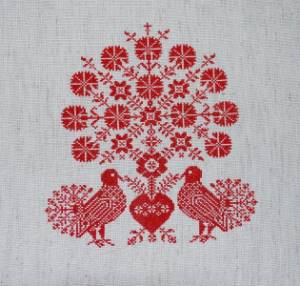
- Yarilo on horseback is a symbol of the vital forces of nature, fertility,
- A woman of life is a sign of fertility, harvest,
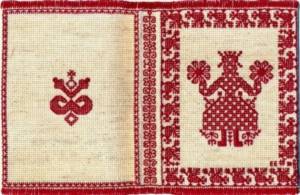
- symbol of ancestors - a pattern that represents a petition, a prayer to God for one’s relatives,
- sun sign,
- symbol of a child - a talisman sign for children,
- the sign of the Mother is a symbol of all living things,
- Beregini's symbol is a sign of family farming, handicrafts,
- a sign of wealth - a symbol of a wish for wealth, prosperity, offspring.
Patterns for embroidering towels with flowers
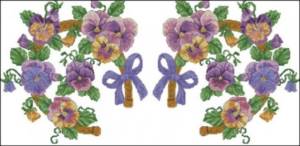
On embroidered towels you can often see flowers that have their own symbolic meaning
- Lily - symbolizes feminine fragility, charm and beauty. These flowers are feminine energy, the symbol of which has always been water. Therefore, a few drops of dew were often embroidered above the flowers, which indicated fertilization.
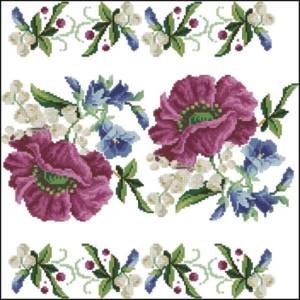
- Poppy is a symbol of protection from evil and memory of the dead.
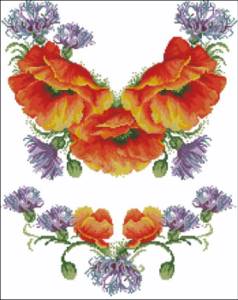
- The red rose is the flower of the Sun, which signifies life. That is why rose ornaments were often embroidered in stripes that had no beginning or end. Such a wreath signifies the infinity of life, rebirth.
- Hops are a sign of activity, enthusiasm, youthful love, and development. Therefore, patterns with embroidered hops are often classified as youth. Sometimes the hop symbol is embroidered on wedding towels because it represents a young family.
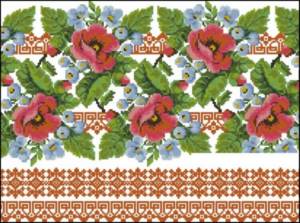
Symbols and ornaments on wedding towels
The symbols that were embroidered on wedding towels were different. All of them were supposed to ensure a happy life for a young family. The most important thing is to guarantee one hundred percent continuation of the family.
For this purpose, the family tree was necessarily embroidered on the wedding towel. There is information that each twig and flower on it symbolized relatives from the family of the bride or groom. Accordingly, his tree was embroidered on the right end of the towel, and hers on the left. Dark branches hanging down symbolized the dead, red branches - the living. The lower the branch was, the older the relative was.
Family tree – World tree
The ancients imagined the World Tree as a special universal core on which the entire universe rests. Its roots go back to the world of the dead. The trunk and branches hold up the world of the living. The top is the divine Iriy. Birds sit here. They were simultaneously considered the messengers of the gods and the souls of unborn children.
According to an ancient belief, future babies fly near the branches of the world tree. From here the stork picks them up and takes them to their future parents.
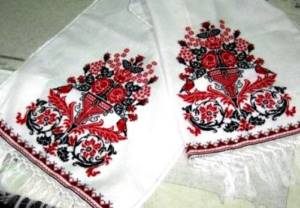
Symbols that help in procreation
Some of the most ancient symbols are “beregins” and “rozhanitsy”. Protectors of the clan since prehistoric times. A stylized image of a mother woman with her legs spread and her arms raised up.
They were also embroidered on towels for newborns. If there were no children in the family, the young woman put these symbols on clothes, towels, and underwear.
Today you won’t surprise anyone with words about the materiality of our thoughts. Embroidery enhances them tenfold. If you want to get married, start embroidering a towel. You need housing - draw a house. As a rule, dreams come true even before the work is completed.
The power of fertility will be shared with the young family by the Sun, Water and Earth. Not a single ancient ornament can do without their signs. Circles, wavy, lines, squares. Here are the signs of the main elements.
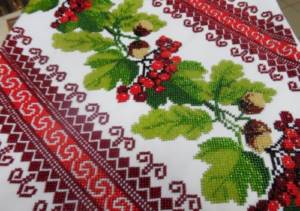
Plants and flowers
The most common male symbols in embroidery are oak, hops and grapes.
- Oak is the tree of the god Perun. A symbol of male power in all its manifestations: health, performance and, of course, sexual energy.
- Hop. Do not be afraid. It will not make your husband an alcoholic. Like oak, hops, in part, are a symbol of the same masculine energy. It will also bring joy and fun into family life.
- Grapes symbolize the same thing as hops. Sometimes you can’t even tell their image in embroidery apart.
Among the female symbols the following can be distinguished:
- Rose is a symbol of beauty, health, fullness of life;
- Lily is a symbol of heavenly fire and maiden innocence;
- The color of viburnum is a symbol of procreation and the purity of the bride. Pay attention, exactly, flowers. Yagoda indicates that the woman already has a family and children. Although, it must be admitted that they are also found in the embroidery of wedding towels. But only viburnum is a symbol of innocence.
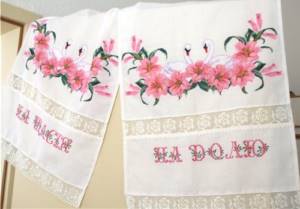
Birds
- Firstly, they are embroidered only in the upper tier. This is one of the most common mistakes today. No place for birds below. Let us remember that they are the messengers of the gods.
- Secondly, the birds should look at each other and sit in pairs.
- On a wedding towel, peacocks or roosters will be appropriate. They will bring prosperity to a young family.
- Swans, doves and nightingales will protect love.
- Some may be surprised, but the cuckoo will give you happiness. The ancients considered her a prophetess responsible for fate. In wedding songs, it is she who informs the bride about the arrival of the groom, and her parents about the imminent separation from their daughter.
The main thing is to embroider a wedding towel with love, prayer and in a good mood. It will retain all the feelings and experiences with which you touched it with a needle.
Bead embroidery pattern for a wedding towel
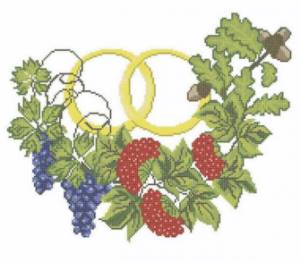
One of the attributes of a wedding event is a towel. Using bead embroidery, you can create a unique copy of a towel, which can become your first family heirloom.
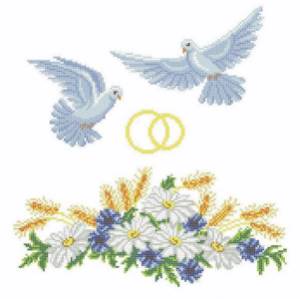
Embroidery does not lose its significance; it remains a subject of admiration, pride, beauty, surprise and great creativity.
